作者观点与态度
阅读技巧大揭秘如何快速找到作者观点和态度

阅读技巧大揭秘如何快速找到作者观点和态度阅读是我们获取知识和信息的重要途径,但有时候在阅读过程中,我们需要更深入地理解作者的观点和态度。
本文将揭示一些阅读技巧,帮助你快速找到作者的观点和态度。
一、理解观点和态度的重要性在阅读中理解作者的观点和态度是至关重要的。
它有助于我们更好地理解文章的主旨和目的,并促使我们对所阅读的内容进行更深入的思考和分析。
同时,了解作者的观点和态度也可以帮助我们评估文章的可信度和客观性。
二、关注词语和表达方式作者表达观点和态度的常用手段是通过特定的词语和表达方式来传达。
在阅读中,我们应该注意以下几点:1. 关键词:注意文章中的关键词,它们通常是强调作者观点的词语。
例如:必然、绝对、无疑等表示确定性的词汇,或者是表示赞同或反对的词汇。
2. 情感词汇:作者用情感词汇来表达自己的态度,例如:愤怒、失望、赞赏等。
这些词汇可以帮助我们判断作者的情感倾向。
3. 修辞手法:作者经常使用各种修辞手法来表达自己的观点和态度,例如比喻、夸张、反问等。
我们可以通过分析这些修辞手法来理解作者的意图。
三、分析文章结构和段落文章的结构和段落有助于我们理解作者的观点和态度。
下面是一些需要注意的方面:1. 开头段落:往往在开头段落中,作者会明确陈述自己的观点和态度。
通过仔细阅读开头段落,我们可以捕捉到作者的关键意图。
2. 转折点:有时作者会使用转折来体现自己的观点和态度的变化。
寻找并理解这些转折点有助于我们把握作者的观点演变过程。
3. 结尾段落:结尾段落通常总结文章的主要观点和态度。
仔细阅读结尾段落可以帮助我们对作者的观点有一个更准确的总结。
四、理解背景和目的了解作者的背景和文章的目的对于理解观点和态度非常重要。
以下几点可以帮助我们更好地掌握这些信息:1. 作者的资历和经验:了解作者的资历和经验有助于我们判断他们在特定话题上的专业性和权威性。
2. 文章的出版背景:考虑文章的出版背景,例如出版日期、媒体平台等,有助于我们理解作者可能存在的立场或偏见。
理解作者的观点与态度

理解作者的观点与态度在理解作者的观点与态度时,我们需要仔细阅读并分析作者在文章中所表达的言辞、观点和情感等元素。
通过深入剖析这些内容,我们可以更好地把握作者的观点和态度,并从中领悟到文章的主旨。
首先,要理解作者的观点和态度,我们需要对文章的中心思想进行准确的解读。
通过分析文章的主题和论点,我们可以确定作者希望传达的信息。
比如,若文章主题是环境保护,作者可能表达对环境污染的担忧,并倡导人们采取积极的行动来保护地球。
其次,我们应该细致地观察和推测作者在文章中所展示的态度。
观察作者对待问题的立场,可以从作者使用的词语、修辞手法以及语气等方面入手。
例如,如果作者使用了很多感情色彩浓厚的形容词和动词,那么我们可以判断作者对待问题充满了强烈的情感和热情。
此外,我们还可以从作者的观点表达和支持论据上来判断作者态度的取向。
作者可能通过使用统计数据、专家意见、历史事件等来支持自己的观点,并试图说服读者接受自己的观点。
通过分析这些论据,我们可以了解到作者在文章中所持的态度和观点。
不仅如此,我们还应该留意文章中的反驳和对立观点。
作者可能通过批驳其他观点来支撑自己的立场,并且通过揭示其他观点的不足来证明自己的观点是正确无误的。
通过把握这些反驳和对立观点,我们可以更好地理解作者的观点和态度。
最后,我们可以通过总结和归纳文章的结构和内容来进一步理解作者的观点和态度。
一个优秀的文章通常具有开头、中间和结尾三部分,每一部分都有自己的功能和特点。
通过分析这些不同部分的内容,我们可以抓住作者的关键观点和态度,并理解其文章的整体思路。
综上所述,要理解作者的观点与态度,我们需要通过分析文章的主旨、推测作者的立场、观察作者在文章中所展示的态度、研究作者的论据和对立观点以及总结文章的结构和内容等方法。
通过深入研究这些方面,我们可以更准确地理解并把握作者的观点与态度。
诗歌鉴赏之评价作者的思想情感以及观点态度省公开课金奖全国赛课一等奖微课获奖课件

介绍他人评价
所暗示内容
暗示诗人创作动机及本诗思想感情。
暗示本诗用典或意境
暗示本诗写作格调,从中琢磨出本诗感情 基调。 暗示本诗艺术特色或本诗思想内容。
22/40
(15天津卷)阅读下面这首诗,按要求作答。(9分) 雨过至城中苏家 【宋】 黄庭坚
飘然一雨洒青春,九陌净无车马尘。渐散紫烟笼帝阙,稍 回晴日丽天津。
2.这首诗后两联表示了作者什么样感情?请简明分析。 (6分)
4/40
(山东卷)阅读下面宋词,回答下列问题。(8 分)
卜算子 张元干 风露湿行云,沙水迷归艇。卧看明河月满空, 斗挂苍山顶。 万古只青天,多事悲人境。起舞闻鸡酒未醒, 潮落秋江冷。 [注]张元干,宋代爱国词人
(2)“起舞闻鸡酒未醒,潮落秋江冷”表示了作 者怎样思想感情? 请做简明分析(4分)
2.诗尾联表示了作者什么样思想感情? 对全诗情 感抒发有怎样作用? (6分)
3/40
(课表卷2)阅读下面这首唐诗。完成1~2题。 残春旅舍 韩偓①
旅舍残春宿雨晴,恍然心地忆咸京②。树头蜂抱 花须落,池面鱼吹柳絮行。
禅伏诗魔归净域,酒冲愁阵出奇兵。两梁免被尘埃 污③,拂拭朝簪待眼明④。 [注]①韩偓(约842~923): 字致尧,京兆万年(今陕西西 安)人,这首诗是作者流徙闽地时所作。②咸京: 这里 借指都城长安③梁: 官帽上横脊,古代以梁多少区分官 阶。④朝簪: 朝廷官员冠饰。
春江渺,断送扁舟过林杪①。愁云清未了,布帆
遥比沙鸥小。恨残照,犹有一竿红,怪人催去早。
【注】①杪:树梢。
(2)怎样了解“怪人催去早”? 请结合全词分析。
(4分)
说明表面意思
答:“怪人催去早”有责备催促者催着要早早离开之
写作中的态度与观点的表达方式
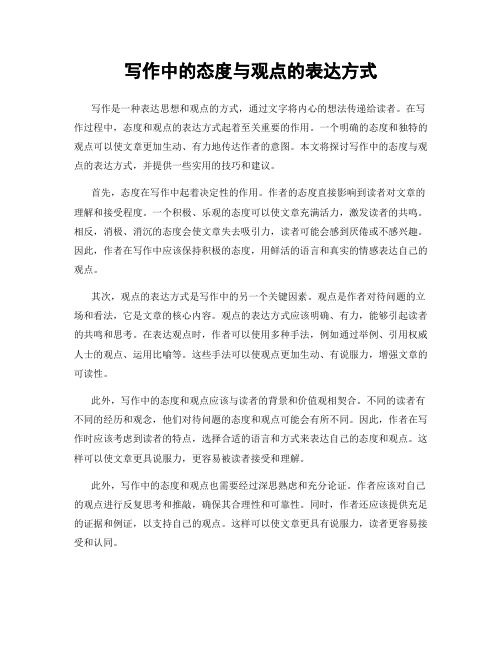
写作中的态度与观点的表达方式写作是一种表达思想和观点的方式,通过文字将内心的想法传递给读者。
在写作过程中,态度和观点的表达方式起着至关重要的作用。
一个明确的态度和独特的观点可以使文章更加生动、有力地传达作者的意图。
本文将探讨写作中的态度与观点的表达方式,并提供一些实用的技巧和建议。
首先,态度在写作中起着决定性的作用。
作者的态度直接影响到读者对文章的理解和接受程度。
一个积极、乐观的态度可以使文章充满活力,激发读者的共鸣。
相反,消极、消沉的态度会使文章失去吸引力,读者可能会感到厌倦或不感兴趣。
因此,作者在写作中应该保持积极的态度,用鲜活的语言和真实的情感表达自己的观点。
其次,观点的表达方式是写作中的另一个关键因素。
观点是作者对待问题的立场和看法,它是文章的核心内容。
观点的表达方式应该明确、有力,能够引起读者的共鸣和思考。
在表达观点时,作者可以使用多种手法,例如通过举例、引用权威人士的观点、运用比喻等。
这些手法可以使观点更加生动、有说服力,增强文章的可读性。
此外,写作中的态度和观点应该与读者的背景和价值观相契合。
不同的读者有不同的经历和观念,他们对待问题的态度和观点可能会有所不同。
因此,作者在写作时应该考虑到读者的特点,选择合适的语言和方式来表达自己的态度和观点。
这样可以使文章更具说服力,更容易被读者接受和理解。
此外,写作中的态度和观点也需要经过深思熟虑和充分论证。
作者应该对自己的观点进行反复思考和推敲,确保其合理性和可靠性。
同时,作者还应该提供充足的证据和例证,以支持自己的观点。
这样可以使文章更具有说服力,读者更容易接受和认同。
最后,写作中的态度和观点的表达方式也需要灵活多样。
不同的主题和文体要求不同的表达方式。
在写作时,作者可以运用一些修辞手法和文学技巧,例如比喻、夸张、对比等,来增强观点的表达效果。
此外,作者还可以结合自己的经验和感受,以个人的方式来表达观点,使文章更具个性和独特性。
总之,写作中的态度和观点的表达方式是至关重要的。
初三阅读材料中的观点态度与作者意分析

初三阅读材料中的观点态度与作者意分析阅读材料是初中生在学习中经常接触到的一种文本形式,它包括了各种各样的文章和短文。
在学习中,师生要对材料中的观点态度和作者意图进行分析,以便更好地理解文章的内容和用意。
本文将就初三阅读材料中的观点态度和作者意图进行深入探讨,并提供一些分析的方法。
首先,对于初三阅读材料中的观点态度分析,我们需要注意作者对所阐述观点的态度。
大多数情况下,作者会采用肯定、否定、中立等不同的态度来描述自己的观点。
我们可以通过分析文章中的修辞手法和用词选择来判断作者的态度。
比如,如果文章中使用了一些强调和赞扬的词语,那么可以判断作者对所阐述观点持肯定的态度。
反之,如果文章中使用了一些贬低和批评的词语,那么可以判断作者对所阐述观点持否定的态度。
其次,对于初三阅读材料中的作者意图分析,我们需要明确作者想要通过文章传达的信息和目的。
在分析作者意图时,我们可以从以下几个方面入手。
首先,我们可以通过分析文章的标题、导语和结尾来确定作者意图。
标题通常会简要概括文章主题,导语会引起读者的注意,结尾会对文章进行总结或呼吁。
其次,我们可以分析文章中的论据和证据,判断作者是否想通过这些论据和证据来支持自己的观点或者引起读者的思考。
最后,我们还可以借助外部的背景知识和文化背景来推测作者意图。
综上所述,初三阅读材料中的观点态度与作者意图分析对于学生的阅读理解能力提出了一定的要求。
在实际阅读中,我们应该注重文本的细节,善于捕捉文章中的观点态度信息和作者意图线索,通过合理的推理和判断来理解和解读文章。
此外,积累丰富的词汇量和知识背景也是提高阅读理解能力的必要条件。
通过不断的练习和积累,我们相信每位初三学生都能成为一位优秀的阅读者。
高中语文必修下册 第五单元 分析作者的观点态度能力培养 课件(部编版)

【阅读示范】 一、思维发展与提升——整体把握文章大意,弄清文章 的整体倾向。
方法:以小组为单位,分别承担探究目标,组内合作 讨论明确答案。
1.全文共5段。
2.文章的论证思路是“总—分—总”结构。 ①段提出中心论点:文艺要扎根人民。 ②段分析问题:文艺创作者与身处的时代积极互动 才会获得艺术创作的蓬勃生机。 ③段举例论证:人民的主体地位。
(3)注意标志性词语,直接概括。 课文范例:《就任北京大学校长之演说》一文提出 了三点希望,阅读时只要注意“一曰”“二曰”“三曰” 这些标志性词语,就能明确作者的观点态度。 (4)联系背景材料,帮助理解,用简洁的语言概括。
【典例研读】 (2019·全国卷Ⅰ)阅读下面的文字,完成1~3题。
①对文学艺术创作者来说,或早或晚,都会遭遇到 这个问题——为谁创作、为谁立言?习近平同志强 调:“文学艺术创造、哲学社会科学研究首先要搞清楚 为谁创作、为谁立言的问题,这是一个根本问题。人民 是创作的源头活水,只有扎根人民,创作才能获得取之 不尽、用之不竭的源泉。”
核心素养探究 分析概括作者的观点态度
梳理角度:分析“观点态度”“分析、概括”含义 所谓“观点”,就是作者对事物所持的看法;所谓 “态度”,就是指作者在文中所表现的思想倾向和感情 倾向,包括肯定与否定、爱与憎、褒与贬,以及某种程 度的保留等。“观点态度”是文章内容的核心,是文章 的灵魂。
“分析、概括”,包括四层含义:准确找出,辨别筛 选,分析归纳,正确表述。
③去过天安门广场的朋友一定会对矗立在广场上 的人民英雄纪念碑印象深刻,许多人都背得出上面的碑 文——“三年以来,在人民解放战争和人民革命中牺牲 的人民英雄们永垂不朽!三十年以来,在人民解放战争 和人民革命中牺牲的人民英雄们永垂不朽!由此上溯到 一千八百四十年,从那时起,为了反对内外敌人,争取
(完整版)作者观点态度题

作者态度观点阅读理解中的题目有的时候会问及作者对于某一事件或者某一问题的观点或者态度是什么,以及作者对文章继续展开的内容判断等,这样的题就是观点态度题.解答这种问题时,考生首先应请注意篇章中的连词,这些连词的运用都暗含着作者的态度和观点,从中可以推敲出作者的意图.然后需要注意有些表明作者观点的词汇和语句,考生就可以根据这些词汇和语句的情感来判断作者的态度。
总体来讲,观点态度的题比较难,对于这类问题的回答,考生应从篇章的体裁和风格入手,再从文章的论述方法、语气和措辞中把握作者对事物的喜好,从而了解作者的情感与态度。
1、观点态度题常见设问方式What’s the tone of the passage?Which of the following best describes the author’s attitude toward…?How does the author feel about…?What’s the author’s opinion of/ about …?What is the author's overall attitude towards …?What does the author think of…?Which of the following is the author most likely to agree with?The author seems to be in favor of the idea of ________.The author probably feels that ________。
The author’s attitude towards …might be best summarized as ________.In the writer’s opinion, ________.According to the author, ________。
初二语文阅读理解中的作者观点态度判断
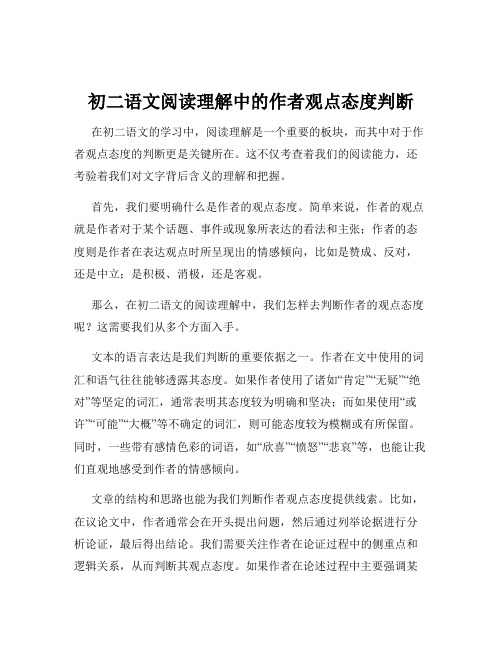
初二语文阅读理解中的作者观点态度判断在初二语文的学习中,阅读理解是一个重要的板块,而其中对于作者观点态度的判断更是关键所在。
这不仅考查着我们的阅读能力,还考验着我们对文字背后含义的理解和把握。
首先,我们要明确什么是作者的观点态度。
简单来说,作者的观点就是作者对于某个话题、事件或现象所表达的看法和主张;作者的态度则是作者在表达观点时所呈现出的情感倾向,比如是赞成、反对,还是中立;是积极、消极,还是客观。
那么,在初二语文的阅读理解中,我们怎样去判断作者的观点态度呢?这需要我们从多个方面入手。
文本的语言表达是我们判断的重要依据之一。
作者在文中使用的词汇和语气往往能够透露其态度。
如果作者使用了诸如“肯定”“无疑”“绝对”等坚定的词汇,通常表明其态度较为明确和坚决;而如果使用“或许”“可能”“大概”等不确定的词汇,则可能态度较为模糊或有所保留。
同时,一些带有感情色彩的词语,如“欣喜”“愤怒”“悲哀”等,也能让我们直观地感受到作者的情感倾向。
文章的结构和思路也能为我们判断作者观点态度提供线索。
比如,在议论文中,作者通常会在开头提出问题,然后通过列举论据进行分析论证,最后得出结论。
我们需要关注作者在论证过程中的侧重点和逻辑关系,从而判断其观点态度。
如果作者在论述过程中主要强调某个方面的好处和优势,那么很可能他对这一方面持赞成态度;反之,如果着重指出其弊端和问题,可能就持反对态度。
此外,作者所选取的事例和引用的材料也能反映其观点态度。
如果作者列举的都是正面的、成功的案例,那么一般来说是为了支持自己的积极观点;而如果引用的多是负面的、失败的例子,则可能是为了表达对某种现象的批判或担忧。
具体到不同的文体,判断作者观点态度的方法也有所差异。
在记叙文当中,作者的观点态度往往蕴含在对人物、事件的描述之中。
我们要通过分析人物的言行举止、心理活动,以及事件的发展和结局,来体会作者想要传达的思想感情。
比如,作者通过描写一个善良勇敢的人物形象,并让他最终获得了成功和幸福,这很可能表达了作者对善良和勇敢品质的赞美与推崇。
如何评价文章的思想和作者的观点态度
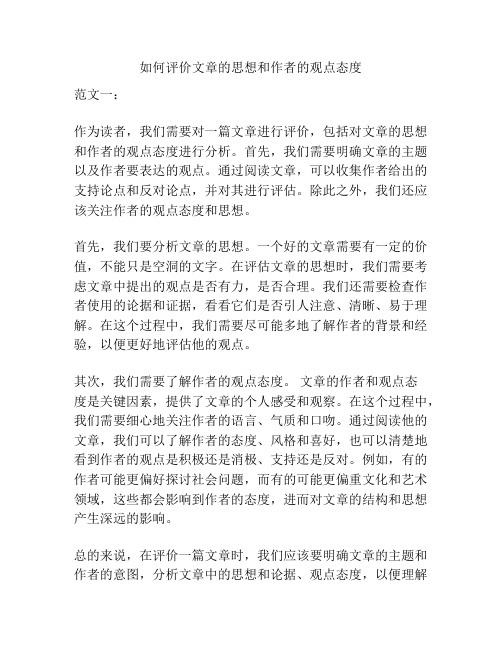
如何评价文章的思想和作者的观点态度范文一:作为读者,我们需要对一篇文章进行评价,包括对文章的思想和作者的观点态度进行分析。
首先,我们需要明确文章的主题以及作者要表达的观点。
通过阅读文章,可以收集作者给出的支持论点和反对论点,并对其进行评估。
除此之外,我们还应该关注作者的观点态度和思想。
首先,我们要分析文章的思想。
一个好的文章需要有一定的价值,不能只是空洞的文字。
在评估文章的思想时,我们需要考虑文章中提出的观点是否有力,是否合理。
我们还需要检查作者使用的论据和证据,看看它们是否引人注意、清晰、易于理解。
在这个过程中,我们需要尽可能多地了解作者的背景和经验,以便更好地评估他的观点。
其次,我们需要了解作者的观点态度。
文章的作者和观点态度是关键因素,提供了文章的个人感受和观察。
在这个过程中,我们需要细心地关注作者的语言、气质和口吻。
通过阅读他的文章,我们可以了解作者的态度、风格和喜好,也可以清楚地看到作者的观点是积极还是消极、支持还是反对。
例如,有的作者可能更偏好探讨社会问题,而有的可能更偏重文化和艺术领域,这些都会影响到作者的态度,进而对文章的结构和思想产生深远的影响。
总的来说,在评价一篇文章时,我们应该要明确文章的主题和作者的意图,分析文章中的思想和论据、观点态度,以便理解文章的真正意义和价值。
重点分析:文章的思想和作者的观点态度是文章评价的关键要素,需要仔细分析。
要点包括明确主题、分析思想和论据、了解作者的态度、和结论。
用词分析:文章运用了一些常见的词汇如“主题”、“观点态度”等来表达文章评价的关键要素,合理使用谓语和形容词来丰富文章的表述。
文章流畅、清晰,避免了过于复杂和晦涩难懂的语句。
范文二:评价一篇文章,需要同时分析文章的思想和作者的观点态度。
在分析思想时,我们需要考虑文章的完整性、逻辑性和连贯性。
我们还需要看看文章使用的语言方法,并评估文学运用技巧是否恰当。
当我们分析观点态度时,我们需要看看作者的语言风格、主题、生活经历,以此推断作者的观点和态度。
分析作者的观点态度

3617分析概括作者在文中的观点态度河南丁彬考点阐述“分析概括作者在文中的观点态度”,是在归纳文章内容要点的基础上对考生提出的更高层次的要求,主要考查考生对文章中心内涵的理解和把握。
具体来说,作者在文中的观点态度,是指文章思想内容的核心,也就是文章的意旨。
其中“观点”就是作者对事物所持的看法,而“态度”则是指作者在文中所表现的思想倾向和感情倾向,包括肯定与否定、爱与憎、褒与贬,以及某种程度的保留等。
我们在完成此类考题时,即要结合文本的文体特征,掌握正确的解题方法,又要做到具体文体具体分析,根据具体语境来揣摩作者的观点态度,只有这样,才能给出客观准确的答案。
考题回放一、阅读《牛铃叮当》一文,完成下面各题。
(2013年浙江卷)。
15.简要概括本文主旨,并谈谈你的感悟。
(5分)解析:题干要求概括文章的中心主旨,主要考查考生对作者在文中的观点态度的分析能力。
文章前半部分主要记叙水牛以往的生存状态,情感倾向以怀念为主;后半部分则主要为水牛的生存现状,可以感受到深深的惋惜和怅惘。
据此我们不难总结出文章的中心主旨。
而关于个人感悟,则可以自由发挥,不管是从乡村生活变好入手来怀念过去的淳朴生活,还是从自然与社会的关系方面展开思考,都符合题意,言之成理即可。
答案:①本文主旨:表达了对淳朴、诗意乡村的眷恋,以及对田园牧歌图景消逝的怅惘。
②考生感悟:略。
解题技巧要想准确把握作者在文中的观点态度,我们必须了解作者表达观点态度的方法和手段,准确找到文中体现作者观点态度的关键。
一般来说,作者的观点态度在不同类型的文章中有不同的表现形态。
论说性的文章,观点明朗、直白,文学作品则比较含蓄。
这就要求我们在分析作者观点态度时,深入把握文章的总结性语句、具有情感色彩的词汇和关于情感倾向的语句,以做到有的放矢。
下面,我们就针对论述和记叙两类文体,谈一谈具体的解题技巧。
一、对于论述类文本,需要从总结性语句和具有明显褒贬色彩的词语入手分析;论述性的文章中,作者的观点主要体现在中心论点、分论点以及某些议论上,文章的中心论点即为作者的观点态度。
2023届高考语文二轮复习专项:诗歌鉴赏之评价作者的观点态度
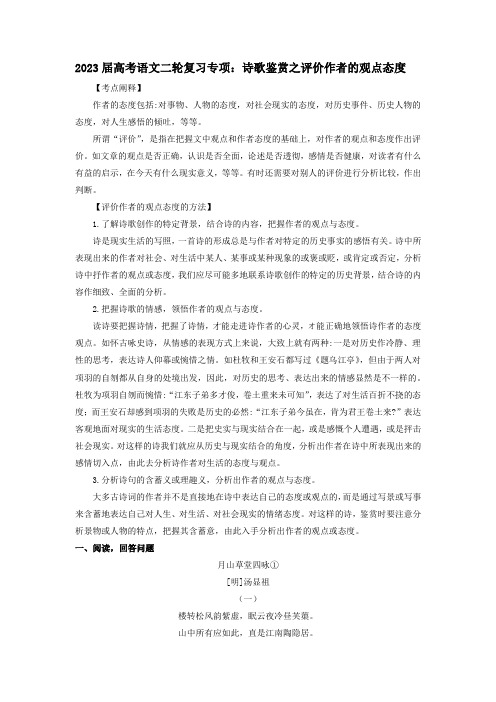
2023届高考语文二轮复习专项:诗歌鉴赏之评价作者的观点态度【考点阐释】作者的态度包括:对事物、人物的态度,对社会现实的态度,对历史事件、历史人物的态度,对人生感悟的倾吐,等等。
所谓“评价”,是指在把握文中观点和作者态度的基础上,对作者的观点和态度作出评价。
如文章的观点是否正确,认识是否全面,论述是否透彻,感情是否健康,对读者有什么有益的启示,在今天有什么现实意义,等等。
有时还需要对别人的评价进行分析比较,作出判断。
【评价作者的观点态度的方法】1.了解诗歌创作的特定背景,结合诗的内容,把握作者的观点与态度。
诗是现实生活的写照,一首诗的形成总是与作者对特定的历史事实的感悟有关。
诗中所表现出来的作者对社会、对生活中某人、某事或某种现象的或褒或贬,或肯定或否定,分析诗中抒作者的观点或态度,我们应尽可能多地联系诗歌创作的特定的历史背景,结合诗的内容作细致、全面的分析。
2.把握诗歌的情感,领悟作者的观点与态度。
读诗要把握诗情,把握了诗情,才能走进诗作者的心灵,オ能正确地领悟诗作者的态度观点。
如怀古咏史诗,从情感的表现方式上来说,大致上就有两种:一是对历史作冷静、理性的思考,表达诗人仰幕或惋惜之情。
如杜牧和王安石都写过《题乌江亭》,但由于两人对项羽的自刎都从自身的处境出发,因此,对历史的思考、表达出来的情感显然是不一样的。
杜牧为项羽自刎而惋惜:“江东子弟多才俊,卷土重来未可知”,表达了对生活百折不挠的态度;而王安石却感到项羽的失败是历史的必然:“江东子弟今虽在,肯为君王卷土来?”表达客观地面对现实的生活态度。
二是把史实与现实结合在一起,或是感慨个人遭遇,或是抨击社会现实。
对这样的诗我们就应从历史与现实结合的角度,分析出作者在诗中所表现出来的感情切入点,由此去分析诗作者对生活的态度与观点。
3.分析诗句的含蓄义或理趣义,分析出作者的观点与态度。
大多古诗词的作者并不是直接地在诗中表达自己的态度或观点的,而是通过写景或写事来含蓄地表达自己对人生、对生活、对社会现实的情绪态度。
分析作者在文中的观点态度的方法
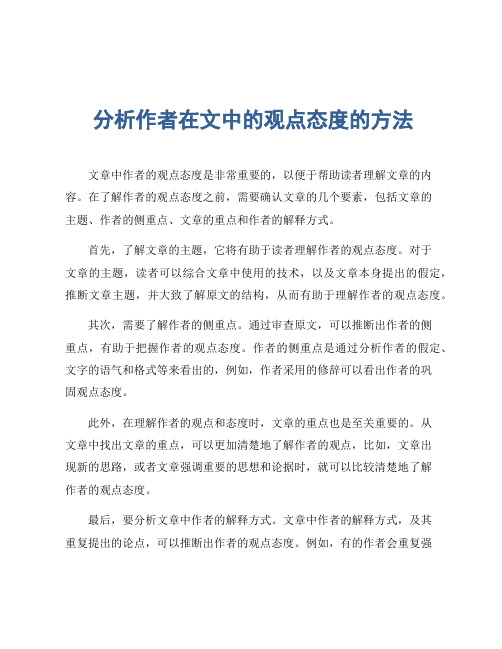
分析作者在文中的观点态度的方法文章中作者的观点态度是非常重要的,以便于帮助读者理解文章的内容。
在了解作者的观点态度之前,需要确认文章的几个要素,包括文章的主题、作者的侧重点、文章的重点和作者的解释方式。
首先,了解文章的主题,它将有助于读者理解作者的观点态度。
对于文章的主题,读者可以综合文章中使用的技术,以及文章本身提出的假定,推断文章主题,并大致了解原文的结构,从而有助于理解作者的观点态度。
其次,需要了解作者的侧重点。
通过审查原文,可以推断出作者的侧重点,有助于把握作者的观点态度。
作者的侧重点是通过分析作者的假定、文字的语气和格式等来看出的,例如,作者采用的修辞可以看出作者的巩固观点态度。
此外,在理解作者的观点和态度时,文章的重点也是至关重要的。
从文章中找出文章的重点,可以更加清楚地了解作者的观点,比如,文章出现新的思路,或者文章强调重要的思想和论据时,就可以比较清楚地了解作者的观点态度。
最后,要分析文章中作者的解释方式。
文章中作者的解释方式,及其重复提出的论点,可以推断出作者的观点态度。
例如,有的作者会重复强调自己的观点,表明强烈的支持;有的作者会质疑对手的观点,表明对对方的反对态度。
这表明作者的观点态度在文章的构成当中具有重要的地位,也可以从作者的解释方式中推断出作者的观点态度。
可以总结出,了解作者的观点态度,可以通过仔细分析文章中所用技术以及文章的几个要素,包括文章的主题、作者的侧重点、文章的重点和作者的解释方式,来帮助读者把握作者的观点态度。
这样有助于帮助读者更好地理解文章的内容,从而获得更有效的读文体会。
中考语文阅读理解中的作者观点与态度
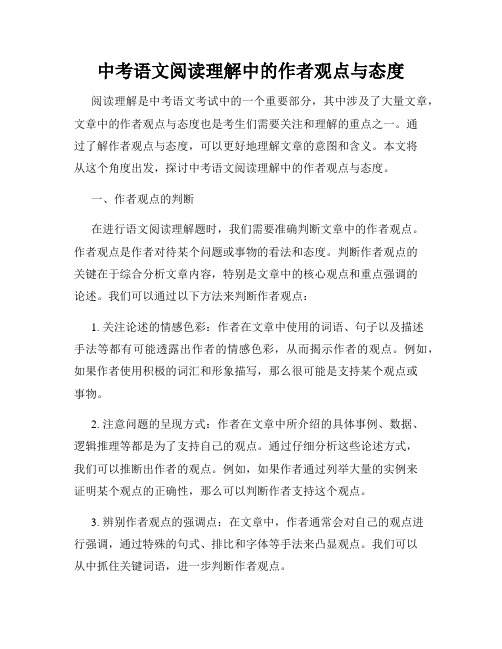
中考语文阅读理解中的作者观点与态度阅读理解是中考语文考试中的一个重要部分,其中涉及了大量文章,文章中的作者观点与态度也是考生们需要关注和理解的重点之一。
通过了解作者观点与态度,可以更好地理解文章的意图和含义。
本文将从这个角度出发,探讨中考语文阅读理解中的作者观点与态度。
一、作者观点的判断在进行语文阅读理解题时,我们需要准确判断文章中的作者观点。
作者观点是作者对待某个问题或事物的看法和态度。
判断作者观点的关键在于综合分析文章内容,特别是文章中的核心观点和重点强调的论述。
我们可以通过以下方法来判断作者观点:1. 关注论述的情感色彩:作者在文章中使用的词语、句子以及描述手法等都有可能透露出作者的情感色彩,从而揭示作者的观点。
例如,如果作者使用积极的词汇和形象描写,那么很可能是支持某个观点或事物。
2. 注意问题的呈现方式:作者在文章中所介绍的具体事例、数据、逻辑推理等都是为了支持自己的观点。
通过仔细分析这些论述方式,我们可以推断出作者的观点。
例如,如果作者通过列举大量的实例来证明某个观点的正确性,那么可以判断作者支持这个观点。
3. 辨别作者观点的强调点:在文章中,作者通常会对自己的观点进行强调,通过特殊的句式、排比和字体等手法来凸显观点。
我们可以从中抓住关键词语,进一步判断作者观点。
二、作者态度的把握作者态度是指作者对待某个问题或事物所表现出的情感态度。
在阅读理解中,正确把握作者态度是解答问题的关键。
以下是几种常见的作者态度:1. 肯定态度:作者对某个事物或观点表示认可和赞同。
这种态度常常通过使用积极的词汇和情感的描写来表达。
例如,作者使用“优秀”、“出色”等词汇来形容某个事物或表达对某个观点的赞同。
2. 反对态度:作者对某个事物或观点持否定的态度。
这种态度常常通过使用否定性的词汇和情感的描写来表达。
例如,作者使用“问题”、“错误”等词汇来表达对某个观点的反对。
3. 中立态度:作者对某个事物或观点持中立或客观的态度,即不偏袒任何一方。
阅读理解技巧理解作者的观点和态度
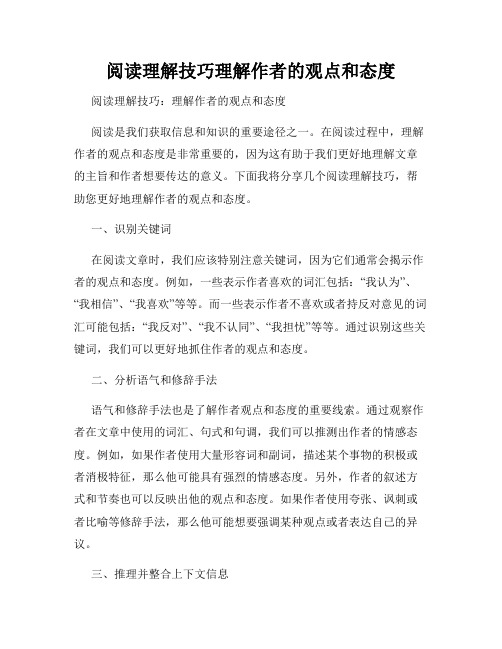
阅读理解技巧理解作者的观点和态度阅读理解技巧:理解作者的观点和态度阅读是我们获取信息和知识的重要途径之一。
在阅读过程中,理解作者的观点和态度是非常重要的,因为这有助于我们更好地理解文章的主旨和作者想要传达的意义。
下面我将分享几个阅读理解技巧,帮助您更好地理解作者的观点和态度。
一、识别关键词在阅读文章时,我们应该特别注意关键词,因为它们通常会揭示作者的观点和态度。
例如,一些表示作者喜欢的词汇包括:“我认为”、“我相信”、“我喜欢”等等。
而一些表示作者不喜欢或者持反对意见的词汇可能包括:“我反对”、“我不认同”、“我担忧”等等。
通过识别这些关键词,我们可以更好地抓住作者的观点和态度。
二、分析语气和修辞手法语气和修辞手法也是了解作者观点和态度的重要线索。
通过观察作者在文章中使用的词汇、句式和句调,我们可以推测出作者的情感态度。
例如,如果作者使用大量形容词和副词,描述某个事物的积极或者消极特征,那么他可能具有强烈的情感态度。
另外,作者的叙述方式和节奏也可以反映出他的观点和态度。
如果作者使用夸张、讽刺或者比喻等修辞手法,那么他可能想要强调某种观点或者表达自己的异议。
三、推理并整合上下文信息阅读理解还需要我们能够推理并整合上下文信息。
有时,作者的观点和态度并未直接表达出来,而是通过其他方式暗示或者间接体现。
这就需要我们在阅读过程中仔细分析文章中的相关信息,并进行推断。
我们可以从作者提供的事实、观点、推理和情感反应等方面入手,整合上下文信息推测出作者真正的观点和态度。
同时,我们还需要注意避免对上下文信息的某一方面过分放大,而应该全面地考虑总体语境,以更准确地把握作者的观点和态度。
四、深入挖掘文章主旨主旨即是作者所要表达的核心思想或者主要观点。
通过理解文章的主旨,我们可以更好地把握作者的观点和态度。
在阅读文章时,我们应该注重整体理解,结合各个方面的信息来分析作者要传达的主要思想。
透过表象,深入挖掘作者的意图,帮助我们更准确地理解作者的观点和态度。
论述文分析概括作者在文中的观点态度优秀

三、客观题和主观题
主观题
常见提问方式: ①(作者认为,)应该……才能……? ②“……”,这种说法正确吗? ③有人认为,……本文作者是否同意这一看 法?为什么?请加以说明。 ④通观全文,简要分析作者对……有什么样 的复杂心情? ⑤作者引用……的用意是什么? ⑥请说明作者对……的态度。
三、分析概括作者观点态度途径
一个原则:整体把握全文 从整体上把握文章的内容主旨。分析文章 的中心内容,把握作者的基本观点和态度。
三条途径:
①从概括性强的句子入手
有的文章的观点是直接表述的,抓住了概括 性强而又表达某种看法的句子,就抓住了作者的 观点态度。 抓关键句和中心句。议论文的论点就是作者 的观点。其标志性语词往往是“认为”、“以 为”、“感到”等。
例1:某年高考题第23题第1问:这篇《创 造宣言》认为教育的最大成功是什么?相 关原文是这样的。
教师的成功,是创造出值得自己崇拜的 人。先生之最大快乐,是创造出值得自己 崇拜的学生。说得正确些,先生创造学生, 学生先生合作而创造出值得彼 学生也创造先生,学生先生合作而创造出 此崇拜之活人。 值得彼此崇拜之活人。倘若创造出丑恶的 活人,不但是所塑之像的失败,亦是合作 塑像之失败。倘若活人之塑像又是由集体 创造的,而不是个人创造的,那么这成功 失败是属于集体,而不仅仅属于个人。
此,行动的原本也是这样。传统的行动痕迹往 往出乎原初行动者的始料之所及,自有后来人 的评说——解释。 这样看,传统形成的过程本身便是一个传 统不断更新、不断开放、不断壮大的过程。传 统本来就具有两面性,它在形成和发展过程中, 既因新的参照系与之相摩擦而不断更新自己, 又因其偏执性而抗拒摩擦,力图使自身永恒化。 可以说,传统既是摩擦的结果,又是对摩擦的 抗拒。那种把传统一味看
古诗词鉴赏之评价作者的观点态度

【知识点:古诗词鉴赏之评价作者的观点态度】作者的观点态度包括:对事物、⼈人物的态度,对社会现实的态度,对历史事件、历史⼈人物的态度,对⼈人⽣生感悟的倾吐,等等。
所谓“评价”,是指在把握⽂文中观点和作者态度的基础上,对作者的观点和态度作出⾃自⼰己的评价:⽂文章的观点是否正确,认识是否全⾯面,论述是否透彻,感情是否健康,对读者有什什么有益的启示,在今天有什什么现实意义。
另外还需要对别⼈人的评价进⾏行行分析⽐比较,作出正确的判断。
评价作者的观点态度,要⽤用历史唯物主义的观点分析评价作者对⼈人和事的看法、倾向。
分析评价时要针对作者所处的社会现状和作者当时的思想认知范围,客观公平、实事求是,既不不能过分地贬低,也不不能拔⾼高。
1.评价古诗的作者的观点态度,除了了上⼀一节中提到的⼋八个⽅方⾯面以外,还需要注意以下⼏几点:(1)整体把握诗意,发挥想像和联想读⼀一⾸首诗,如不不从整体上把握其意境,是很难深刻理理解诗的含意的。
古诗讲究“启、承、转、合”,意思是前⾯面⼏几句句往往是为表情达意蓄势,⽽而最后的诗句句才是诗⼈人要表达的主旨。
创作诗歌需要联想和想像,同样地,鉴赏诗歌也离不不开联想与想像。
诗歌的语⾔言⾼高度简洁凝练,作者为读者留留下了了相当⼤大的⾃自由想像与联想的空间。
透过⼀一些关键字词,读者可以联系诗⼈人本身,想像诗⼈人创作时的⼼心情、感受、处境等,也可以联系⾃自⼰己的⽣生活体验,由⼰己推⼈人,从⽽而⾛走进诗⼈人的内⼼心世界。
(2)从背景出发诗歌也是现实⽣生活的写照,⼀一⾸首诗的形成总是与作者对特定的历史事实的感悟有关。
诗中所表现出来的作者对社会,对⽣生活中的某⼈人、某事或某种现象的或褒或贬,或肯定或否定,或赞美或嘲讽总是带有时代烙烙印的。
因此,联系诗歌创作的特定的历史背景,对感受作者思想感情,明⽩白作者观点态度是有很⼤大帮助的。
因⽽而特别提醒考⽣生,千万别忽视了了诗词后所附的有关注释。
这些解释,有的交代了了创作的年年代,有的交代了了创作的缘由,有的交代了了创作的经过,有的交代了了创作的背景,有的提示了了作品的情感基调,它对理理解作品的思想内容也是⾄至关重要的,往往能帮助考⽣生准确把握全诗的思想主题,因⽽而不不能忽视。
英文阅读理解表观点态度的词语

英文阅读理解表观点态度的词语
在英文阅读理解中,表达作者观点和态度的词语非常重要。
这些词语能够帮助读者更好地理解文章的立场、思想和情感。
下面是一些常用的表达作者观点和态度的词语:
1. Advocate:支持者,提倡者。
通常指文章作者支持某一观点、政策或立场。
2. Criticize:批评,指责。
文章作者对某一观点、政策或立场持批判态度,提出批评和指责。
3. Challenge:质疑,挑战。
文章作者对某一观点、政策或立场存在疑虑,提出质疑和挑战。
4. Agree:同意,赞同。
文章作者认同某一观点、政策或立场,表达自己的认同和支持。
5. Disagree:不同意,反对。
文章作者对某一观点、政策或立场持否定态度,表达自己的不同意见和反对。
6. Suggest:建议,提议。
文章作者针对某一问题或情况提出建议、提议或解决方案。
7. Emphasize:强调,着重。
文章作者强调某一观点、事实或情况的重
要性和紧迫性。
8. Question:质问,问询。
文章作者对某一观点、事实或情况提出质疑
和询问。
9. Expose:揭露,曝光。
文章作者揭露某一事实、事件或情况的真相,通常带有强烈的批判意味。
10. Support:支持,拥护。
文章作者对某一观点、政策或立场持肯定态度,表达自己的支持和拥护。
总之,这些词语都是表达作者观点和态度的常见工具,在阅读理解中
可以帮助读者更好地理解文章的立场和情感。
作者在文中观点态度的分析和概括
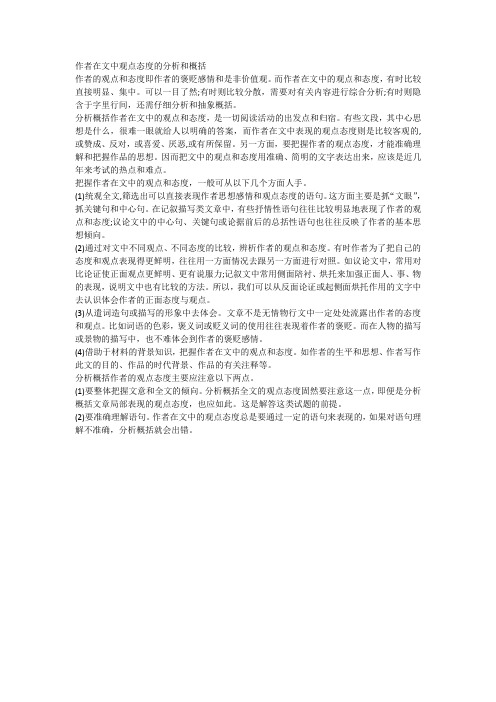
作者在文中观点态度的分析和概括作者的观点和态度即作者的褒贬感情和是非价值观。
而作者在文中的观点和态度,有时比较直接明显、集中。
可以一目了然;有时则比较分散,需要对有关内容进行综合分析;有时则隐含于字里行间,还需仔细分析和抽象概括。
分析概括作者在文中的观点和态度,是一切阅读活动的出发点和归宿。
有些文段,其中心思想是什么,很难一眼就给人以明确的答案,而作者在文中表现的观点态度则是比较客观的,或赞成、反对,或喜爱、厌恶,或有所保留。
另一方面,要把握作者的观点态度,才能准确理解和把握作品的思想。
因而把文中的观点和态度用准确、简明的文字表达出来,应该是近几年来考试的热点和难点。
把握作者在文中的观点和态度,一般可从以下几个方面人手。
(1)统观全文,筛选出可以直接表现作者思想感情和观点态度的语句。
这方面主要是抓“文眼”,抓关键句和中心句。
在记叙描写类文章中,有些抒情性语句往往比较明显地表现了作者的观点和态度;议论文中的中心句、关键句或论据前后的总括性语句也往往反映了作者的基本思想倾向。
(2)通过对文中不同观点、不同态度的比较,辨析作者的观点和态度。
有时作者为了把自己的态度和观点表现得更鲜明,往往用一方面情况去跟另一方面进行对照。
如议论文中,常用对比论证使正面观点更鲜明、更有说服力;记叙文中常用侧面陪衬、烘托来加强正面人、事、物的表现,说明文中也有比较的方法。
所以,我们可以从反面论证或起侧面烘托作用的文字中去认识体会作者的正面态度与观点。
(3)从遣词造句或描写的形象中去体会。
文章不是无情物行文中一定处处流露出作者的态度和观点。
比如词语的色彩,褒义词或贬义词的使用往往表现着作者的褒贬。
而在人物的描写或景物的描写中,也不难体会到作者的褒贬感情。
(4)借助于材料的背景知识,把握作者在文中的观点和态度。
如作者的生平和思想、作者写作此文的目的、作品的时代背景、作品的有关注释等。
分析概括作者的观点态度主要应注意以下两点。
(1)要整体把握文意和全文的倾向。
- 1、下载文档前请自行甄别文档内容的完整性,平台不提供额外的编辑、内容补充、找答案等附加服务。
- 2、"仅部分预览"的文档,不可在线预览部分如存在完整性等问题,可反馈申请退款(可完整预览的文档不适用该条件!)。
- 3、如文档侵犯您的权益,请联系客服反馈,我们会尽快为您处理(人工客服工作时间:9:00-18:30)。
(二)作者观点题和态度题
在一篇文章中,不管作者对某一观点是支持、反对还是中立,是同情、冷漠还是失望,是批评还是赞扬,主观还是客观,都表达了作者一定的观点和态度。
只是这些观点态度的提出有的直截了当,有的隐含在字里行间,有的通过所用词语的褒贬来体现,有的则需要通读全文,把握主旨才能领会。
一般情况下,所选的文章不带有强烈的感情色彩,因此不会引起太大的争议和分歧。
此类题型可细分为作者态度题(表明作者的好恶)和作者观点题(表明作者对某事物的观点)。
题干中的关键词或词组有attitude,opinion,tone等等。
其命题模式如下。
1 作者态度题
(1)What is the tone (mood) of the passage?
(2)The author’s attitude towards...might be summarized as(seems to be) .
(3)Which of the following can best describe the attitude of the author towards...?
(4)The author is most critical of .
2 作者观点题
(1)According to the author, .
(2)In the author’s opinion, .
(3)What is the author’s opinion (idea) about?
(4)The author thinks (believes, suggests, deems, asserts) that .
(5) In the author’s eyes...
态度题的选项一般是形容词,按照作者对所阐述问题的态度进行分类,可以分为:
积极类:objective(客观的), impartial(公正的),helpful(有帮助的),positive(正确的),supporting(支持的),admiring(羡慕的),interesting(引起兴趣的),unbiased(没有偏见的),concerned(关心的),confident(自信的),impressive(给人印象深刻的),optimistic(乐观的)等;
中立类:detached(超然的), factual(实际的), indifferent (无关紧要的),impassive(冷漠的),uninterested(不感兴趣的),ambivalent(矛盾的),apathetic(无动于衷的),neutral (中立的,不确定的),impersonal(不带个人色彩的)等;
消极类:disgusting(令人厌恶的),critical(批评的),
negative(否定的),intolerable(不能忍受的),disappointed(失望的),subjective(主观的),biased(有偏见的),doubtful(怀疑的),compromising(折中的),worried(担心的),pessimistic(悲观的),hostile(敌对的)等。
历年作者态度题:
第一,某一事物是好是坏。
作者对它是支持还是反对,态度都非常明确,而带中立色彩的词最不可能是正确答案。
问作者对某事物的态度时,表示“客观”的词多为正确选项,如:objective, impartial, unbiased等;问作者对其提到的人们的观点的态度时,答案只能是肯定或否定,支持或反对。
如:critical, approval,
opposition, supporting等。
第二,既然写了文章,那么作者的态度就不可能漠不关心,因此见到indifferent,uninterested这类词可以首先排除。
第三,注意不要把考生自己的好恶态度糅进其中,要注意区分作者本人的态度和作者引用的观点的态度。
第四,当作者的态度没有明确提出时,考生要学会根据作者使用的词语的褒贬性去判断作者态度,如:wonderful(y),successful(y),positive(ly),active(ly),negative(ly), unfortunate(ly), doubtful(ly)等。
Example
Under the new Northern Territory law, an adult patient can request death probably by a deadly injection or pill—to put an end to suffering. The patient must be diagnosed as terminally ill by two doctors. After a “cooling off” period of seven days, the patient can sign a certificate of request. After 48 hours the wish for death can be met. For Lloyd Nickson, a 54-year-old Darwin resident suffering from lung cancer, the NT Rights of Terminally Ill law means he can get on with living without the haunting fear of his suffering: a terrifying death from his breathing condition. “I’m not afraid of dying from a spiritual point of view, but what I was afraid of was how I’d go, because I’ve watched people die in the hospital fighting for oxygen and clawing at their masks, ”he says.(1997年Passage 1)
The author’s attitude towards euthanasia seems to be that of .
[A] opposition [B] suspicion [C] approval
[D] indifference
作者通过living without the haunting fear of his suffering这一肯定性词语表达出自己的态度是[C] approval。
解答态度观点题应注意两点:
第一,区别作者的态度与其他人的态度。
问文中某人对某事物的态度一般归入事实细节题。
第二,选项可能不再是态度明确的肯定或否定的形容词,而改为带有程度限制的形容词。
一般带有绝对化或过于强烈的表示态度的词必错,如strong/complete/entire/enthusiastic等。
而有保留的态度比较客观,因此常常是正确选项,如reserved(保留的)/qualified (有限制的,有条件的)/tempered (有所控制
的)/guarded(慎重的)/consent (赞同)等。
4 作者观点题的解题技巧
第一,文章陈述的内容并非都是作者的观点。
作者引用别人的观点时,是作为支持或抨击的对象,因此别人的观点是为了证明作者观点的论据。
第二,作者观点一般与文章主旨相关联。
